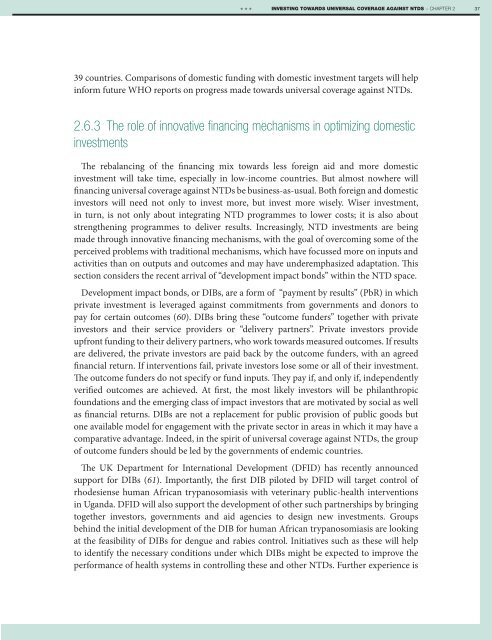1A9bnbK
1A9bnbK
1A9bnbK
Create successful ePaper yourself
Turn your PDF publications into a flip-book with our unique Google optimized e-Paper software.
***<br />
INVESTING TOWARDS UNIVERSAL COVERAGE AGAINST NTDS − CHAPTER 2<br />
37<br />
39 countries. Comparisons of domestic funding with domestic investment targets will help<br />
inform future WHO reports on progress made towards universal coverage against NTDs.<br />
2.6.3 The role of innovative fi nancing mechanisms in optimizing domestic<br />
investments<br />
The rebalancing of the financing mix towards less foreign aid and more domestic<br />
investment will take time, especially in low-income countries. But almost nowhere will<br />
financing universal coverage against NTDs be business-as-usual. Both foreign and domestic<br />
investors will need not only to invest more, but invest more wisely. Wiser investment,<br />
in turn, is not only about integrating NTD programmes to lower costs; it is also about<br />
strengthening programmes to deliver results. Increasingly, NTD investments are being<br />
made through innovative financing mechanisms, with the goal of overcoming some of the<br />
perceived problems with traditional mechanisms, which have focussed more on inputs and<br />
activities than on outputs and outcomes and may have underemphasized adaptation. This<br />
section considers the recent arrival of “development impact bonds” within the NTD space.<br />
Development impact bonds, or DIBs, are a form of “payment by results” (PbR) in which<br />
private investment is leveraged against commitments from governments and donors to<br />
pay for certain outcomes (60). DIBs bring these “outcome funders” together with private<br />
investors and their service providers or “delivery partners”. Private investors provide<br />
upfront funding to their delivery partners, who work towards measured outcomes. If results<br />
are delivered, the private investors are paid back by the outcome funders, with an agreed<br />
financial return. If interventions fail, private investors lose some or all of their investment.<br />
The outcome funders do not specify or fund inputs. They pay if, and only if, independently<br />
verified outcomes are achieved. At first, the most likely investors will be philanthropic<br />
foundations and the emerging class of impact investors that are motivated by social as well<br />
as financial returns. DIBs are not a replacement for public provision of public goods but<br />
one available model for engagement with the private sector in areas in which it may have a<br />
comparative advantage. Indeed, in the spirit of universal coverage against NTDs, the group<br />
of outcome funders should be led by the governments of endemic countries.<br />
The UK Department for International Development (DFID) has recently announced<br />
support for DIBs (61). Importantly, the first DIB piloted by DFID will target control of<br />
rhodesiense human African trypanosomiasis with veterinary public-health interventions<br />
in Uganda. DFID will also support the development of other such partnerships by bringing<br />
together investors, governments and aid agencies to design new investments. Groups<br />
behind the initial development of the DIB for human African trypanosomiasis are looking<br />
at the feasibility of DIBs for dengue and rabies control. Initiatives such as these will help<br />
to identify the necessary conditions under which DIBs might be expected to improve the<br />
performance of health systems in controlling these and other NTDs. Further experience is


